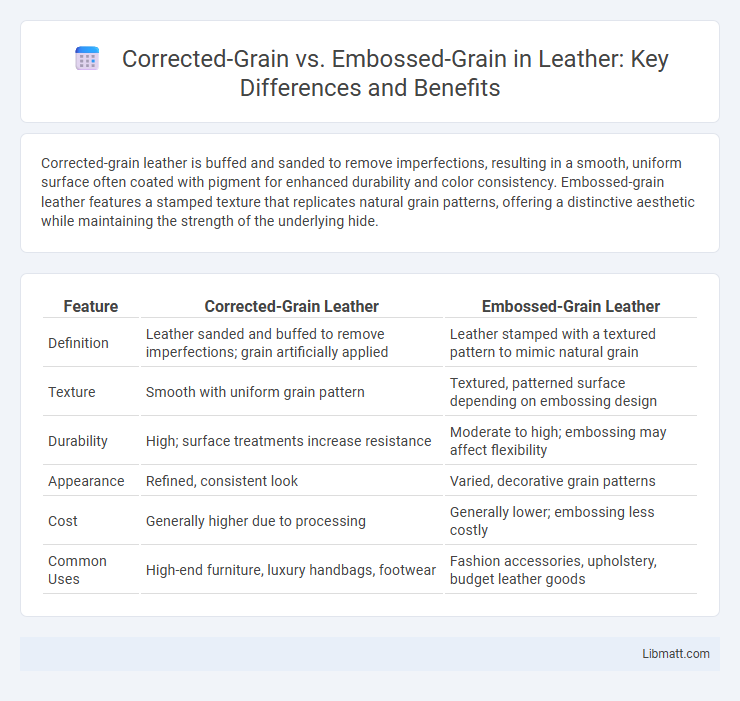Corrected-grain leather is buffed and sanded to remove imperfections, resulting in a smooth, uniform surface often coated with pigment for enhanced durability and color consistency. Embossed-grain leather features a stamped texture that replicates natural grain patterns, offering a distinctive aesthetic while maintaining the strength of the underlying hide.
Table of Comparison
| Feature | Corrected-Grain Leather | Embossed-Grain Leather |
|---|---|---|
| Definition | Leather sanded and buffed to remove imperfections; grain artificially applied | Leather stamped with a textured pattern to mimic natural grain |
| Texture | Smooth with uniform grain pattern | Textured, patterned surface depending on embossing design |
| Durability | High; surface treatments increase resistance | Moderate to high; embossing may affect flexibility |
| Appearance | Refined, consistent look | Varied, decorative grain patterns |
| Cost | Generally higher due to processing | Generally lower; embossing less costly |
| Common Uses | High-end furniture, luxury handbags, footwear | Fashion accessories, upholstery, budget leather goods |
Understanding Leather Grains: An Overview
Corrected-grain leather features a buffed surface that removes imperfections before applying an artificial grain pattern, offering durability and uniformity. Embossed-grain leather is created by pressing a design onto the leather surface, mimicking natural grain patterns while allowing for greater aesthetic variety. Understanding these differences helps you select the right leather grain for quality, appearance, and intended use.
What is Corrected-Grain Leather?
Corrected-grain leather is leather that has been sanded and buffed to remove imperfections, then coated with a synthetic layer to create a uniform surface. This process enhances durability and provides a consistent texture, often used in furniture and fashion goods. Unlike embossed-grain leather, which retains the original hide's natural markings with an imprinted pattern, corrected-grain leather hides its natural look under a smooth finish.
What is Embossed-Grain Leather?
Embossed-grain leather is a type of corrected-grain leather that features a surface pattern created through heat-pressing techniques to imitate natural textures such as alligator or pebble grain. This process enhances durability and uniformity, making embossed-grain leather more resistant to wear and scratches compared to untreated leathers. You benefit from its consistent appearance and long-lasting quality, especially in products like upholstery and fashion accessories.
Differences in Manufacturing Processes
Corrected-grain leather undergoes a detailed sanding and buffing process to remove surface imperfections, followed by the application of artificial grain patterns and coatings to create a uniform texture. Embossed-grain leather retains the natural grain underneath but is stamped with a heated plate to imprint specific patterns, enhancing its appearance while preserving some original characteristics. The primary manufacturing difference lies in the level of surface treatment, with corrected-grain relying on extensive surface alteration and embossed-grain emphasizing pattern application on the existing leather surface.
Surface Appearance and Texture Comparison
Corrected-grain leather features a smooth, uniform surface achieved through sanding and buffing to remove imperfections, resulting in a refined and polished appearance ideal for formal leather goods. Embossed-grain leather mimics natural grain patterns through stamped designs, creating a textured surface that enhances visual depth and provides a more rugged, tactile feel suitable for casual or decorative applications. The choice between corrected and embossed grain primarily affects the leather's aesthetic and texture, influencing its suitability for various styles and uses.
Durability and Wear Resistance
Corrected-grain leather undergoes extensive sanding and buffing to remove surface imperfections, resulting in a smoother finish with moderate durability and wear resistance suitable for everyday use. Embossed-grain leather features an impressed grain pattern that mimics natural textures, enhancing its surface strength and providing superior resistance to scratches, scuffs, and wear over time. The manufacturing process of embossed-grain leather typically reinforces the material's resilience, making it more durable and long-lasting compared to corrected-grain leather in high-traffic applications.
Usage in Leather Goods Industry
Corrected-grain leather features a sanded and coated surface, making it ideal for durable leather goods like wallets and belts where a consistent finish is crucial. Embossed-grain leather imitates natural textures through stamping, commonly used in handbags and shoes to offer aesthetic variety while maintaining moderate durability. Your choice depends on whether uniform appearance or textured design suits the product's function and style requirements.
Pros and Cons of Corrected-Grain Leather
Corrected-grain leather features a sanded and coated surface that hides imperfections, making it more durable and resistant to stains compared to natural leather. Its main advantage is affordability and uniform appearance, but the process removes the natural texture, resulting in less breathability and a synthetic feel. If you prioritize durability and a consistent look for frequent use items, corrected-grain leather offers a practical solution despite sacrificing some of the authentic leather quality.
Pros and Cons of Embossed-Grain Leather
Embossed-grain leather offers a consistent texture that masks natural imperfections, making it an affordable option for those seeking uniform appearance and easy maintenance. However, its synthetic pattern can lack the unique character and breathability of corrected-grain leather, potentially impacting durability and aging quality. Your choice depends on whether you prioritize cost efficiency and low upkeep over authentic texture and long-term wear.
Choosing the Right Leather: Corrected vs. Embossed-Grain
Choosing the right leather involves understanding key differences between corrected-grain and embossed-grain types, especially for durability and appearance. Corrected-grain leather features a sanded and coated surface to hide imperfections, offering a uniform texture ideal for heavy-use applications. Embossed-grain leather is stamped with a pattern to mimic natural grain, providing aesthetic appeal while maintaining moderate durability and cost-effectiveness.
Corrected-grain vs embossed-grain Infographic

 libmatt.com
libmatt.com